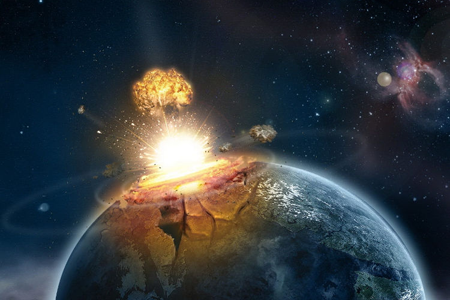ASTEROID That Killed DINOSAURS Might Create Life In Other Solar Systems. Paying It Forward ++
Here’s a potential happy ending to Jurassic Park. The asteroid that wiped out the dinosaurs and thereby deprived me of my (don’t think about it logically you assholes) T. Rex that I ride around like a car could have seeded life throughout the rest of the galaxy.
io9:
Exogenesis is the theory that the building blocks for life came from elsewhere in the universe. The trouble is it doesn’t explain where those building blocks came from in the first place. But new calculations suggest one intriguing source: Earth.
Obviously, we’re not talking about life arriving on Earth from other worlds here – the exact opposite, in fact. There’s a certain sense to this. After all, Earth is the only place in the universe that we actually know for a fact contains life. So if we’re going to talk about the possibility of organic building blocks traveling through space to help create life, it makes just as much sense to consider how those compounds could come from Earth as go to our home planet. There could be planets and moons, both in and out of our solar system, that have life on them because of organic material that came from Earth.
All this is strictly theoretical, of course, and there are a couple major stumbling blocks. The first is just how the Earth’s organic material could leave our planet and head into space in the first place. Well, new calculations by Japan’s Kyoto Sangyo University suggest that the most likely way for microbes and other extremely simple forms of life to leave Earth and survive is to travel on rocks kicked up by massive impact events. We rather famously had one such impact event 65 million years ago.
Now, as New Scientist reports, the trillion-ton asteroid that killed the dinosaurs could have helped Earth seed our entire corner of the galaxy with life:
The team calculated how much of that stuff could have ended up on the bodies in the solar system thought most likely to be hospitable to life: Saturn’s moon Enceladus and Jupiter’s moon Europa, both of which are thought to have subsurface oceans of liquid water. Under certain conditions, as many as 300 million individual rocks could have ended up on Europa, and 500 on Enceladus, they calculated. Even more could have ended up on the moon and Mars.
A handful of rocks could even have made it to planets around other stars. Once such could be Gliese 581, a red dwarf 20 light years away with a super-Earth orbiting at the outer edge of its habitable zone, where water could be liquid. [The researchers] calculated that about 1000 rocks from the Chicxulub impact could have reached that far in about a million years, meaning any life that made it would have had 64 million years to develop – or die off.
Shit yeah it’s all theoretical, but isn’t that where the fun is? It’s also insanely dope to think about the fact that the impact was so severe that it sent things that far into the solar system/galaxy.




